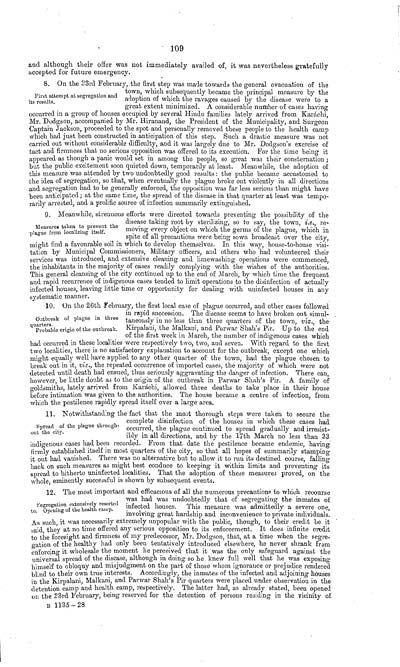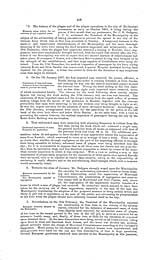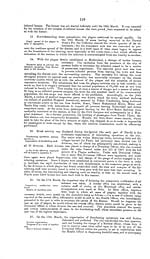Medicine - Disease > Account of plague administration in the Bombay Presidency from September 1896 till May 1897
(121) Page 109
Download files
Individual page:
Thumbnail gallery: Grid view | List view

109
and although their offer was not immediately availed of, it was nevertheless gratefully
accepted for future emergency.
First attempt at segregation and
its results.
8. On the 23rd February,. the first step was made towards the general evacuation of the
town, which subsequently became the principal measure by the
adoption of which the ravages caused by the disease were to a
great extent minimized. A considerable number of cases having
occurred in a group of houses occupied by several Hindu families lately arrived from Karchi,
Mr. Dodgson, accompanied by Mr. Hiranand, the President of the Municipality, and Surgeon
Captain Jackson, proceeded to the spot and personally removed these people to the health camp
which had just been constructed in anticipation of this step. Such a drastic measure was not
carried out without considerable difficulty, and it was largely due to Mr. Dodgson's exercise of
tact and firmness that no serious opposition was offered to its execution. For the time being it
appeared as though a panic would set in among the people, so great was their consternation;
but the public excitement soon quieted down, temporarily at least. Meanwhile, the adoption of
this measure was attended by two undoubtedly good results: the public became accustomed to
the idea of segregation, so that, when eventually the plague broke out violently in all directions
and segregation had to be generally enforced, the opposition was far less serious than might have
been anticipated; at the same time, the spread of the disease in that quarter at least was tempo-
rarily arrested, and a prolific source of infection summarily extinguished.
Measures taken to prevent the
plague from localizing itself.
9. Meanwhile, strenuous efforts were directed towards preventing the possibility of the
disease taking root by sterilizing, so to say, the town, i.e., re-
moving every object on which the germs of the plague, which in
spite of all precautions were being sown broadcast over the city,
might find a favourable soil in which to develop themselves. In this way, house-to-house visi-
tation by Municipal Commissioners, Military officers, and others who had volunteered their
services was introduced, and extensive cleaning and limewashing operations were commenced,
the inhabitants in the majority of cases readily complying with the wishes of the authorities.
This general cleansing of the city continued up to the end of March, by which time the frequent
and rapid recurrence of indigenous cases tended to limit operations to the disinfection of actually
infected houses, leaving little time or opportunity for dealing with uninfected houses in any
systematic manner.
Outbreak of plague in three
quarters.
Probable origin of the outbreak.
10. On the 26th February, the first local case of plague occurred, and other cases followed
in rapid succession. The disease seems to have broken out simul-
taneously in no less than three quarters of the town, viz., the
Kirpalani, the Malkani, and Parwar Shah's Pir. Up to the end
of the first week in March, the number of indigenous cases which
had occurred in these localities were respectively two, two, and seven. With regard to the first
two localities, there is no satisfactory explanation to account for the outbreak, except one which
might equally well have applied to any other quarter of the town, had the plague chosen to
break out in it, viz., the repeated occurrence of imported cases, the majority of which were not
detected until death had ensued, thus seriously aggravating the danger of infection. There can,
however, be little doubt as to the origin of the outbreak in Parwar Shah's Pir. A family of
goldsmiths, lately arrived from Karchi, allowed three deaths to take place in their house
before intimation was given to the authorities. The house became a centre of infection, from
which the pestilence rapidly spread itself over a large area.
Spread of the plague through-
out the city.
11. Notwithstanding the fact that the most thorough steps were taken to secure the
complete disinfection of the houses in which these cases had
occurred, the plague continued to spread gradually and irresist-
ibly in all directions, and by the 17th March no less than 33
indigenous cases had been recorded. From that date the pestilence became endemic, having
firmly established itself in most quarters of the city, so that all hopes of summarily stamping
it out had vanished. There was no alternative but to allow it to run its destined course, falling
back on such measures as might best conduce to keeping it within limits and preventing its
spread to hitherto uninfected localities. That the adoption of these measures proved, on the
whole, eminently successful is shown by subsequent events.
Segregation extensively resorted
to. Opening of the health camp.
12. The most important and efficacious of all the numerous precautions to which recourse
was had was undoubtedly that of segregating the inmates of
infected houses. This measure was admittedly a severe one,
involving great hardship and inconvenience to private individuals.
As such, it was necessarily extremely unpopular with the public, though, to their credit be it
said, they at no time offered any serious opposition to its enforcement. It does infinite credit
to the foresight and firmness of my predecessor, Mr. Dodgson, that, at a time when the segre-
gation of the healthy had only been tentatively introduced elsewhere, he never shrank from
enforcing it wholesale the moment he perceived that it was the only safeguard against the
universal spread of the disease, although in doing so he knew full well that he was exposing
himself to obloquy and misjudgment on the part of those whom ignorance or prejudice rendered
blind to their own true interests. Accordingly, the inmates of the infected and adjoining houses
in the Kirpalani, Malkani, and Parwar Shah's Pir quarters were placed under observation in the
detention camp and health camp, respectively. The latter had, as already stated, been opened
on the 23rd February, being reserved for the detention of persons residing in the vicinity of
B 1135 - 28
and although their offer was not immediately availed of, it was nevertheless gratefully
accepted for future emergency.
First attempt at segregation and
its results.
8. On the 23rd February,. the first step was made towards the general evacuation of the
town, which subsequently became the principal measure by the
adoption of which the ravages caused by the disease were to a
great extent minimized. A considerable number of cases having
occurred in a group of houses occupied by several Hindu families lately arrived from Karchi,
Mr. Dodgson, accompanied by Mr. Hiranand, the President of the Municipality, and Surgeon
Captain Jackson, proceeded to the spot and personally removed these people to the health camp
which had just been constructed in anticipation of this step. Such a drastic measure was not
carried out without considerable difficulty, and it was largely due to Mr. Dodgson's exercise of
tact and firmness that no serious opposition was offered to its execution. For the time being it
appeared as though a panic would set in among the people, so great was their consternation;
but the public excitement soon quieted down, temporarily at least. Meanwhile, the adoption of
this measure was attended by two undoubtedly good results: the public became accustomed to
the idea of segregation, so that, when eventually the plague broke out violently in all directions
and segregation had to be generally enforced, the opposition was far less serious than might have
been anticipated; at the same time, the spread of the disease in that quarter at least was tempo-
rarily arrested, and a prolific source of infection summarily extinguished.
Measures taken to prevent the
plague from localizing itself.
9. Meanwhile, strenuous efforts were directed towards preventing the possibility of the
disease taking root by sterilizing, so to say, the town, i.e., re-
moving every object on which the germs of the plague, which in
spite of all precautions were being sown broadcast over the city,
might find a favourable soil in which to develop themselves. In this way, house-to-house visi-
tation by Municipal Commissioners, Military officers, and others who had volunteered their
services was introduced, and extensive cleaning and limewashing operations were commenced,
the inhabitants in the majority of cases readily complying with the wishes of the authorities.
This general cleansing of the city continued up to the end of March, by which time the frequent
and rapid recurrence of indigenous cases tended to limit operations to the disinfection of actually
infected houses, leaving little time or opportunity for dealing with uninfected houses in any
systematic manner.
Outbreak of plague in three
quarters.
Probable origin of the outbreak.
10. On the 26th February, the first local case of plague occurred, and other cases followed
in rapid succession. The disease seems to have broken out simul-
taneously in no less than three quarters of the town, viz., the
Kirpalani, the Malkani, and Parwar Shah's Pir. Up to the end
of the first week in March, the number of indigenous cases which
had occurred in these localities were respectively two, two, and seven. With regard to the first
two localities, there is no satisfactory explanation to account for the outbreak, except one which
might equally well have applied to any other quarter of the town, had the plague chosen to
break out in it, viz., the repeated occurrence of imported cases, the majority of which were not
detected until death had ensued, thus seriously aggravating the danger of infection. There can,
however, be little doubt as to the origin of the outbreak in Parwar Shah's Pir. A family of
goldsmiths, lately arrived from Karchi, allowed three deaths to take place in their house
before intimation was given to the authorities. The house became a centre of infection, from
which the pestilence rapidly spread itself over a large area.
Spread of the plague through-
out the city.
11. Notwithstanding the fact that the most thorough steps were taken to secure the
complete disinfection of the houses in which these cases had
occurred, the plague continued to spread gradually and irresist-
ibly in all directions, and by the 17th March no less than 33
indigenous cases had been recorded. From that date the pestilence became endemic, having
firmly established itself in most quarters of the city, so that all hopes of summarily stamping
it out had vanished. There was no alternative but to allow it to run its destined course, falling
back on such measures as might best conduce to keeping it within limits and preventing its
spread to hitherto uninfected localities. That the adoption of these measures proved, on the
whole, eminently successful is shown by subsequent events.
Segregation extensively resorted
to. Opening of the health camp.
12. The most important and efficacious of all the numerous precautions to which recourse
was had was undoubtedly that of segregating the inmates of
infected houses. This measure was admittedly a severe one,
involving great hardship and inconvenience to private individuals.
As such, it was necessarily extremely unpopular with the public, though, to their credit be it
said, they at no time offered any serious opposition to its enforcement. It does infinite credit
to the foresight and firmness of my predecessor, Mr. Dodgson, that, at a time when the segre-
gation of the healthy had only been tentatively introduced elsewhere, he never shrank from
enforcing it wholesale the moment he perceived that it was the only safeguard against the
universal spread of the disease, although in doing so he knew full well that he was exposing
himself to obloquy and misjudgment on the part of those whom ignorance or prejudice rendered
blind to their own true interests. Accordingly, the inmates of the infected and adjoining houses
in the Kirpalani, Malkani, and Parwar Shah's Pir quarters were placed under observation in the
detention camp and health camp, respectively. The latter had, as already stated, been opened
on the 23rd February, being reserved for the detention of persons residing in the vicinity of
B 1135 - 28
Set display mode to: Large image | Zoom image | Transcription
Images and transcriptions on this page, including medium image downloads, may be used under the Creative Commons Attribution 4.0 International Licence unless otherwise stated. ![]()
| India Papers > Medicine - Disease > Account of plague administration in the Bombay Presidency from September 1896 till May 1897 > (121) Page 109 |
|---|
| Permanent URL | https://digital.nls.uk/74517252 |
|---|




